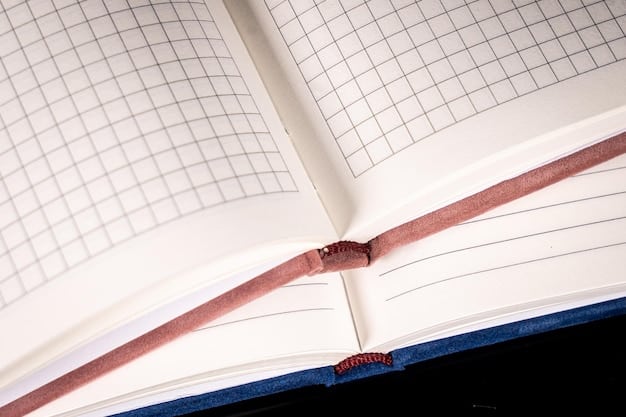Effective Note-Taking Strategies: Linear, Cornell & More

Note-taking strategies range from linear outlines to the Cornell method, each offering unique benefits; finding the best method enhances learning, retention, and academic success by catering to individual learning styles.
Effective note-taking strategies are essential for academic success, improved comprehension, and better retention of information. Whether you’re attending lectures, reading textbooks, or participating in meetings, adopting the right note-taking method can significantly enhance your learning experience.
Understanding different note-taking techniques
Different note-taking strategies cater to various learning styles and types of content. Understanding these techniques is the first step in finding the method that works best for you. Each strategy has unique advantages and disadvantages, making it important to experiment and adapt as needed.
Linear note-taking
Linear note-taking is one of the simplest and most straightforward methods. It involves writing down information in a sequential, continuous manner. This method is best suited for lectures and presentations where information is presented in a logical order.
Cornell method
The Cornell method divides a page into three or four sections: notes, cues, summary, and sometimes a review section. This system promotes active listening and facilitates organization and review.

Mind mapping
Mind mapping, also known as spider diagram, is a non-linear method that visually structures information around a central topic. Mind maps are great for brainstorming and exploring connections between different ideas.
- Linear Note-Taking: Ideal for structured lectures, easy to follow, but can become overwhelming.
- Cornell Method: Enhances organization and review, but requires more initial setup.
- Mind Mapping: Stimulates creativity and understanding of relationships, but may be less structured.
Selecting the right note-taking approach involves considering factors such as content type, personal preference, and learning style. Each technique provides a unique method for capturing, organizing, and reviewing information.
Benefits of effective note-taking
Effective note-taking strategies positively influence learning by enhancing comprehension, boosting recall, and aiding in efficient review. These benefits extend beyond academic performance, influencing decision-making and problem-solving abilities.
Enhanced comprehension
The act of note-taking requires active listening and critical thinking, leading to a deeper understanding of the material. Compressing and rephrasing information fosters better comprehension.
Improved recall
Notes serve as powerful memory aids, helping you remember key concepts and details long after the initial learning experience. Reviewing notes regularly reinforces memory and strengthens understanding.
Efficient review
Well-organized notes provide a concise summary of the material, making it easier to review and prepare for exams or discussions. Streamlined notes save time and focus attention on essential content.

Effective note-taking not only captures what is being taught or discussed but also transforms it into a personal learning tool that enhances comprehension, retention, and efficient review.
Linear note-taking: when and how to use it
Linear note-taking strategy is a straightforward approach, ideal for environments where information is presented sequentially. Mastering this technique requires understanding its simplicity and knowing how to enhance it for better comprehension.
Best scenarios for linear note-taking
Linear note-taking is most effective in lectures, meetings, and presentations where information is given in a clear, step-by-step format. It helps in capturing the flow of information as it is presented.
Tips for effective linear note-taking
To enhance linear note-taking, focus on summarizing information, using abbreviations, and organizing notes into clear, labeled sections. These practices can make notes more valuable.
Potential pitfalls and how to avoid them
Linear note-taking sometimes leads to verbatim transcription without critical engagement. Avoiding this requires focusing on understanding and summarizing, rather than copying every word.
- Ideal Situations: Use for structured lectures to maintain simplicity and flow.
- Enhancement Strategies: Summarize key points, employ abbreviations for efficiency.
- Common Issues: Avoid verbatim copying; focus on understanding.
Incorporating strategic summarizing, using abbreviations, and thoughtfully organizing content supports the effectiveness of linear note-taking. Identifying and correcting potential pitfalls transforms this method into an excellent learning tool.
Cornell method: a structured approach
The Cornell method is a highly structured note-taking strategy designed to facilitate not only note-taking but also easy recall and review. This method’s unique layout and summarizing techniques offer a distinct advantage over other note-taking approaches.
Setting up your page
To start using the Cornell method, divide your paper into sections: a wide note-taking area, a cues section on the left, and a summary section at the bottom. This setup supports effective organization and review.
Taking notes in the main section
In the main note-taking area, record notes as usual, focusing on capturing key points and ideas. Use abbreviations, symbols, and short-hand to keep up with the presenter or content.
Using the cues section for recall
After the session, use the cues section to write key words or questions that summarize or highlight the main points in the adjacent note-taking area. This promotes recall and understanding.
The Cornell Method provides a comprehensive and organized system for effective note-taking, recall, and review, improving academic performance.
Mind mapping: visual connections
Mind mapping, a visual note-taking strategy, is highly effective for brainstorming, creative problem-solving, and seeing connections between different ideas. This non-linear method stimulates both sides of the brain, enhancing memory and understanding.
Creating a central idea
Start by writing the main topic in the center of a page and circle or box it. This central idea serves as the focal point of your mind map, guiding the rest of your notes.
Branching out with subtopics
From the central idea, draw branches to represent subtopics or related ideas. Label each branch with a keyword or phrase that captures the essence of that topic.
Connecting ideas with visuals
Use colors, symbols, and images to connect ideas and make the mind map more memorable and engaging. Visual cues help in recalling information and understanding relationships.
- Central Idea: Serves as the map’s focal point.
- Subtopics: Branch out from the central idea, each labeled distinctively.
- Visuals: Enhance memory and understanding, making connections easier to remember.
Mind mapping’s unique approach to note-taking, enhancing memory and understanding through visual connections and creative layout.
Choosing the best method for you
Selecting the optimal note-taking strategies hinges on personal learning style, content type, and environment. Aligning note-taking practices with individual traits greatly enhances academic and professional effectiveness.
Consider your learning style
Understanding whether you are a visual, auditory, or kinesthetic learner is crucial in selecting an effective note-taking strategy. Tailoring your approach to your learning style can significantly enhance retention and comprehension.
Match the method to the content
Different types of content may require different note-taking approaches. For example, structured lectures may benefit from linear notes, while brainstorming sessions are well-suited to mind mapping.
Evaluate the environment
The setting where you take notes can also influence the best method to use. For example, a quiet library may allow for more detailed Cornell notes, while a fast-paced meeting may necessitate quick linear notes.
Choosing the right note-taking strategy involves assessing personal learning styles, matching the technique to the content, and evaluating the environment. This holistic approach improves note-taking relevance and efficacy.
| Key Point | Brief Description |
|---|---|
| ✍️ Linear Note-Taking | Sequential method for structured lectures. |
| 🧑🏫 Cornell Method | Organized system for note-taking and review. |
| 🧠 Mind Mapping | Visual method for brainstorming and connecting ideas. |
| 🧐 Learning Style | Adapt methods to suit visual, auditory, or kinesthetic styles. |
FAQ
▼
The Cornell method involves dividing your note paper into sections: notes, cues, and a summary, fostering better organization for active learning and efficient review, enhancing comprehension and recall.
▼
Mind mapping enhances note-taking by visually linking ideas, making it easier to see the relationships between concepts, thus boosting memory and creativity in information processing and retention.
▼
Linear note-taking is effective when information is presented sequentially, but it might not suit content requiring deeper connections or visualization; mind mapping or the Cornell method may be preferable.
▼
If you miss information during a lecture, leave space in your notes, use abbreviations to catch up, and revisit the content later via recordings or classmates notes to ensure accuracy.
▼
Review notes soon after taking them to reinforce memory, and then regularly before assessments. Consistent, scheduled review is key to retaining information and ensuring long-term understanding.
Conclusion
Choosing the right note-taking strategies is a personalized journey, influenced by content, setting, and style. Whether you opt for the structured elegance of the Cornell method, the flowing simplicity of linear notes, or the creative freedom of mind mapping, the goal remains the same: to capture, retain, and utilize information effectively, enhancing both academic and professional pursuits. The best approach is often a blend of strategies, tailored to meet your individual needs and maximize your learning potential.





